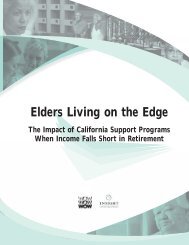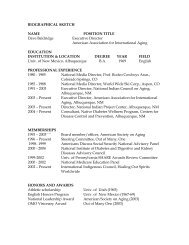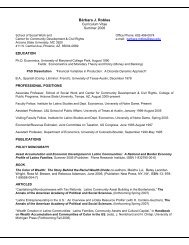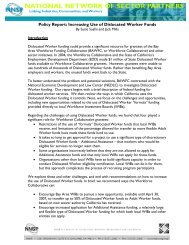Saving Patterns and Probability of Success in Individual ...
Saving Patterns and Probability of Success in Individual ...
Saving Patterns and Probability of Success in Individual ...
You also want an ePaper? Increase the reach of your titles
YUMPU automatically turns print PDFs into web optimized ePapers that Google loves.
<strong>Sav<strong>in</strong>g</strong> <strong>Patterns</strong> <strong>and</strong> <strong>Probability</strong> <strong>of</strong> … 11<br />
deposits. Inclusion <strong>of</strong> <strong>in</strong>active accounts would have resulted <strong>in</strong> yet another bias <strong>in</strong> favor <strong>of</strong><br />
regular savers which is not captured <strong>in</strong> N. This is because regular savers clearly cannot be<br />
<strong>in</strong>active. Their high deposit ratio automatically <strong>in</strong>dicates that the participant is active <strong>and</strong> is<br />
sav<strong>in</strong>g. While for savers with low deposit ratios, it is impossible to dist<strong>in</strong>guish between irregular<br />
savers <strong>and</strong> those who have been <strong>in</strong>active for a long period <strong>of</strong> time. To adjust for this bias, for<br />
every participant, we have looked at the last month they made a deposit <strong>and</strong> have compared it to<br />
the number <strong>of</strong> months to complete deposits. This ratio (L/J), also known as the activity ratio, has<br />
a direct relationship with the level <strong>of</strong> activeness <strong>in</strong> the program. Low values <strong>of</strong> this ratio suggest<br />
that the participant is <strong>in</strong>active, while values close to one suggests activeness, regardless <strong>of</strong><br />
frequency <strong>of</strong> bank visits. As an example, imag<strong>in</strong>e John <strong>and</strong> Jane Smith both opened their<br />
accounts on 07/01/2004 <strong>and</strong> both have saved $800 <strong>in</strong> their accounts. John is <strong>in</strong>active <strong>and</strong> made<br />
only two $400 deposits <strong>in</strong> the first two months <strong>of</strong> program while Jane is active <strong>and</strong> visits the<br />
bank once every quarter <strong>and</strong> deposits $200 <strong>in</strong> her account. By 06/30/05 both had spent 12<br />
months <strong>in</strong> the program. John made his last deposit <strong>in</strong> the second month <strong>and</strong> Jane made her last<br />
deposit <strong>in</strong> May <strong>of</strong> 2005. The activity ratio for John is 0.16, while the activity ratio for Jane is<br />
0.91. Inclusion <strong>of</strong> this variable among other explanatory variables conveniently separates the<br />
impact <strong>of</strong> regularity <strong>in</strong> sav<strong>in</strong>g from the level <strong>of</strong> activeness or <strong>in</strong>activity <strong>in</strong> the program.<br />
F<strong>in</strong>ally, due to differences <strong>in</strong> sav<strong>in</strong>gs limits, ceteris paribus, savers <strong>in</strong> the microenterprise IDAs<br />
will be able to reach their sav<strong>in</strong>gs goals relatively sooner than the homeownership savers. To<br />
account for this difference a dummy variable, P, was added to the model with the value (P=1) for<br />
the microenterprise <strong>and</strong> (P=0) for the homeownership IDAs.<br />
11














